レーザー保護メガネ、安全規格認証済み
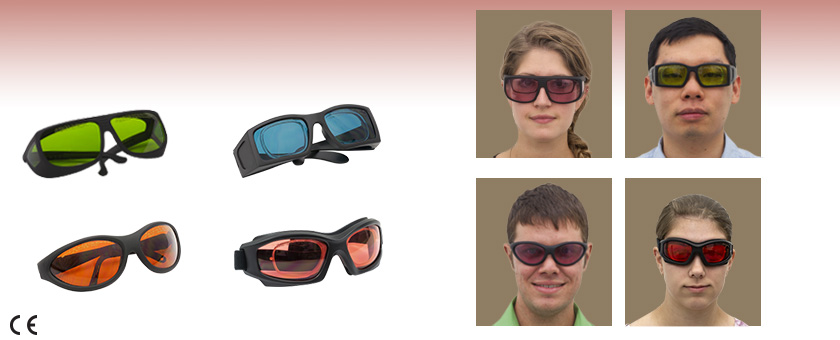
- CE Certified Laser Safety Glasses
- Wide Selection of Wavelength Ranges
- Variety of Frame Styles and Included Carrying Case
LG2
Universal Style
LG10B
Sport Style
LG4A
Comfort Style
Universal Style
LG14C
Modern Goggle Style
Comfort Style
Sport Style
Modern Goggle Style

Please Wait

特長
- レーザ吸収染料を封入した(割れにくい)硬化ポリカーボネート製レンズ*
- EN 207規格内で最大の露光に対して、メガネの保護機能は最低でも10秒間持続します(「仕様チュートリアル」タブ参照)
- 複数のフレームタイプをご用意
- 下記に準拠した適合証明書をご用意しております。
- ANSI Z136.1 Standards for Safe Use of Lasers(LG16シリーズを除く)
- ANSI Z87.1-2003 Standards for Occupational and Educational Personal Eye and Face Protection Devices(LG16シリーズを除く)
- EN 207 Standards(LG14シリーズを除く。「仕様チュートリアル」タブ参照)
- EN 208 Laser Alignment Standards(LG13とLG14シリーズのみ。「仕様チュートリアル」タブ参照)
こちらのレーザ保護メガネは、CE認証された保護性能を有しています。LG11シリーズを除くレンズ部分はすべてレーザ吸収染料を封入した硬化ポリカーボネート製です。非常に割れにくく、小さい傷もつかないためレーザに対する保護性能に影響が生じない作りとなっております。レーザ保護メガネLG11(A)ではSchottガラスを使用しています。*
仕様に示す波長範囲における光学濃度(OD)ならびにLBレーティングが、レンズまたはフレームに印字されています。その印字は、視野範囲を妨げず、また恒久的に消えない方法で刻印されています。光学濃度とLBレーティングのリストについては、右表の型番をクリックしてご覧ください。
当社ではレーザ保護メガネのフレームを4種類ご用意しています(詳細は「フレームタイプ」タブをご覧ください)。
- ユニバーサルタイプ*は、度付き眼鏡の上から着用可能で、サイドとトップ部分にも周囲のレーザ放射から目を保護するシールドが付いています。
- コンフォートタイプのフレームには度付きレンズを脱着できるインサートが付いています(レンズをインサートに合わせたい場合には医師にご相談ください)。またブリッジ部分は長くなっているので、鼻梁が低い方にはより快適にお使いいただけます。
- スポーツタイプは顔を包むようなタイプとなっているので、視野範囲の連続性を保ちつつ目をレーザから完全に保護します。
- そして、ゴーグルタイプには度付きレンズを脱着できるインサートと調整機能付きストラップが組み込まれており、フレームとしては最もしっかり固定できるタイプです。
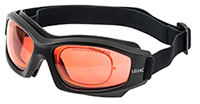
Click for Details
ネックストラップが組み込まれたゴーグルタイプ
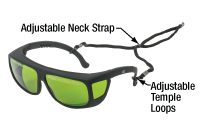
Click to Enlarge
ユニバーサルタイプにはネックストラップが別途付属しています。こちらのネックストラップはユニバーサルタイプ、コンフォートタイプ、スポーツタイプに付属しています。
各製品には、保護ケース、クリーニングクロス、調整機能付きネックストラップが付属します。ゴーグルタイプについては、ネックストラップが組み込まれているため、単体のネックストラップは付属していません。
お手入れについて
使用していないときには保護ケースに入れ、温度が26.6 °Cを超えない場所で保管してください。付属のクリーニングクロスは、レンズ表面の埃を拭き取る際にご使用ください。一般的な度付きメガネ用のクリーニング用品も、当社のレーザ保護メガネに安全にご使用いただけます 洗浄には、中性洗剤、石鹸とお湯、またはイソプロピルアルコール(70%まで)の溶液を推奨します。高濃度の苛性アルカリ溶液はお勧めいたしません。いずれの手順でもレーザ安全レーティングに影響を与えません。
適切なレーザ保護メガネの選択
適切なレーザ保護メガネの選択にあたっては、光路、レーザーパラメータ、使用環境など様々な要因について現場で評価を行う必要があるため、当社では具体的な保護メガネを推奨することはできません。ご所属先のレーザ安全管理者にご相談ください。
*LG11およびLG11AはSchottガラス製で、ほかのレーザ保護メガネとは異なるフレームを使用しています。度付きレンズの上に重ねて使用することができない場合がございますのでご注意ください(詳細は「フレームタイプ 」タブをご参照ください)。こちらの眼鏡はCE規格に準拠する2種類のみでご用意しております。光学濃度と LBレーティングの仕様は、メガネのフレームに印字されています。
†当社のレーザー保護メガネは、その最高の保護性能を発揮させるために、製造日から5年を超えた製品は使用しないでください。すべてのレーザー保護メガネ(型番LG11およびLG11Aを除く)には、その右のレンズの右下に製造日のコードが刻印されています(こちらをご参照ください)。製造日コードは5桁の数字で表されており、最初の2桁が年、最後の3桁がその年の日付を表しています。当社では耐用年数が3年未満のレーザー保護メガネは出荷いたしません。
OD to % Transmittance Conversions
| OD | Transmittance | OD | Transmittance |
|---|---|---|---|
| 0.0 | 100% | 5.0 | 0.001% |
| 1.0 | 10% | 6.0 | 0.0001% |
| 2.0 | 1% | 7.0 | 0.00001% |
| 3.0 | 0.1% | 8.0 | 0.000001% |
| 4.0 | 0.01% | 9.0 | 0.0000001% |


OD = 光学濃度
T = 透過率
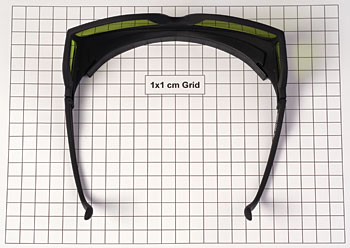
1 x 1 cmのグリッドの上に置いたユニバーサルタイプのレーザ保護メガネLG1。内寸法が分かります。
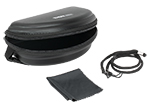
Click to Enlarge
各製品には、保護ケース、クリーニングクロス、調整機能付きネックストラップが付属します(ゴーグルタイプには、単体のネックストラップは付属しません)。
ユニバーサルタイプ
ユニバーサルタイプのレーザ保護メガネのフレームは、度付き眼鏡の上からでも着用できる大型サイズ(145 mm x 53 mm)となっております。 レンズと同じ材質のサイドシールドとフレームと同じ素材のトップシールドにより、周囲への視野を確保しつつ目をレーザ放射から保護します。 フレームのアーム長は調整可能で、様々なテンプルサイズに対応します。 特定の波長範囲における保護レベルを示したレーザ安全情報がレンズ上に印字されています。
LG11は、Schottガラス製でほかのユニバーサルタイプのレーザ保護メガネとは違うフレームを使用しています。サイドシールドがプラスチック製でレーザ光は通しませんが、視野は狭くなっております。 またこのレーザ保護メガネは度付き眼鏡の上から着用できない場合があります。レーザ安全情報は、左側のサイドシールドの上に印字されていて、レンズ上には印字されていません。
コンフォートタイプ
コンフォートタイプの眼鏡のフレームサイズは中程度(145 mm x 47 mm)で、サイドのシールドが周辺のレーザ放射から目を保護します。 こちらのタイプは、度付き眼鏡の上から着用することができませんが、度付きレンズを脱着できるインサートが付いています(右の写真をクリックするとご覧いただけます)。 レンズをインサートに合わせたい場合には医師にご相談ください。 フレームには長めのブリッジが付いているので、鼻梁が低い方にとってフィット感が良くなっております。 特定の波長範囲における保護レベルを示したレーザ安全情報がレンズ上(LG11Aの場合はフレーム)に印字されています。
スポーツタイプ
スポーツタイプの眼鏡フレームはコンパクト(134 mm x 48 mm)で、完全に視野を覆う設計により、サイドシールドが必要なく、広い視野をもたらします。 このフレームタイプの眼鏡は、長さやアームのジョイント部が調整できるので(右の図をクリックするとご覧いただけます)、頭の形や大きさに合わせたフィット感にカスタマイズ可能です。 スポーツタイプの眼鏡は、度付き眼鏡の上から着用できません。また度付きレンズ用インサートも付属しておりません。 特定の波長範囲における保護レベルを示したレーザ安全情報がレンズ上に印字されています。
ゴーグルタイプ
ゴーグルタイプには調整可能なストラップと目の周囲に密着するガスケットが付いており、また曇り止め用の穴が加工されています。ゴーグルの内寸は133 mm x 51 mmです。レンズの対角長は66 mmです。ゴーグルタイプには度付きレンズを脱着できるインサートが付いています(度付きレンズについては医師にご相談ください)。特定の波長範囲における保護レベルを示したレーザ安全情報がレンズ上に印字されています。
*** このガイドは、ANSI Z136やEN 207もしくはEN 208のレーザ安全規格を理解するための参考資料として用意されたものではありません。このチュートリアルはLGシリーズのレーザ保護眼鏡レンズに付けられたマークをご理解いただくための概要を説明したものです***
ANSI Z136およびEN 207規格
レーザ安全保護眼鏡には容易には消えない方法で2つの数字が印字されています: 1つは光学濃度(OD)、もう1つはLBレーティングで、いずれも特定の波長範囲に対する保護レベルを表す数字です。眼鏡にしっかりと印字されたOD値は、任意のレーザ製品が出射するレーザに対して、眼鏡がANSI Z136規格が規定するレーザ安全基準を満たすレベルであるかどうかを表しています。さらにOD値は安全保護眼鏡の透過率(T)を計算するために用いることができます。

欧州のレーザ安全保護眼鏡に関する規格であるEN 207では、保護眼鏡にCEマークとLBレーティング仕様が容易に消えない方法により表示されていることを規定しています。またこの規定は、レーザーモー ドによって10秒または100パルスの間は規定のレベルで保護特性を発揮することも要求しています。LBレーティングには3つの要素があります:波長範囲、 レーザーモード、スケールナンバです。レーザ保護安全眼鏡に刻印された波長範囲は、 nmで表記されていて、保護安全眼鏡の保護性能は波長に依存するのでこの情報は極めて重要です。レーザーモードは、レーザが放出するレーザーパルスの継続時間に基づいています。
レーザーモードの表示
| Laser Mode | Engraved Symbol | Pulse Duration |
|---|---|---|
| Continuous Wave (CW) | D | >0.25 s |
| Pulsed Mode | I | >1µs - 0.25 s |
| Giant Pulsed Mode | R | 1 ns - 1µs |
| Mode Locked | M | <1ns |
| 上記の情報についてはBSIの公式 EN 207規格の内容をご参照ください。 | ||
スケールナンバ(LBn)は波長範囲やレーザーモードと併せて使用していただく数字で、安全保護眼鏡が指定されたレーザに対して必要な最小限度の保護水準を満たしているかを判断するために用いられます。下の表をご参照ください。LBレーティングの一部に共通の情報が含まれていれば、表記される記号をできるだけ短くするために、複数の波長範囲、レーザーモードやスケールナンバの区切りとして+記号が用いられます。さらに「>」という不等号が波長範囲の前にある時、その指定範囲最小値を超える波長から指定範囲最大値を含む波長でモードやスケールナンバは有効であることを示します。例えば、眼鏡のレーティン グが 330-370 D LB2で、 >370-500 D LB3 であった場合、370 nmでのレーティングは D LB2で、370 nmを超えて500 nm以下の波長のレーティングはD LB3となります。
レーザ保護メガネ選択のための欧州基準
| Wavelength Range | Laser Mode | Maximum Power Density (P) or Maximum Energy Density (E) | Minimum Scale Number (Ln) |
|---|---|---|---|
| 180 - 315 nm | D | 1x10n-3 W/m2 (1x10n-7 W/cm2) | log10(P)+3 |
| I and R | 3x10n+1 J/m2 (3x10n-3 J/cm2) | log10(E/3)-1 | |
| M | 3x10n+10 W/m2 (3x10n+6 W/cm2) | log10(P)-10 | |
| >315 - 1400 nm | D | 1x10n+1 W/m2 (1x10n-3 W/cm2) | log10(P)-1 |
| I and R | 5x10n-3 J/m2 (5x10n-7 J/cm2) | log10(E/5)+3 | |
| M | 1.5x10n-4 J/m2 (1.5x10n-8 J/cm2) | log10(E/1.5)+4 | |
| >1400 - 1000000 nm | D | 1x10n+3 W/m2 (1x10n-1 W/cm2) | log10(P)-3 |
| I and R | 1x10n+2 J/m2 (1x10n-2 J/cm2) | log10(E)-2 | |
| M | 1x10n+11 W/m2 (1x10n+7 W/cm2) | log10(P)-11 | |
| 上記の情報についてはBSIの公式 EN 207 規格の内容をご参照ください。 | |||
上記の表を使うには2つの方法があります。1つは特定のスケールナンバを定めて安全なパワー密度の最大値を計算する方法で、もう1つは特定のパワー密度を定めて安全なスケールナンバの最小値を計算する方法です。これらの計算の例を以下に示します。
例1: LG3のレーザ安全保護眼鏡に記してあるLBレーティング情報は「180-315 D LB7 + IR LB4」となっています。このLG3の眼鏡を10 µsパルスの280 nm光源に対して使用したとします。上の表を見るとE=3x10n+1 J/m2という数式が見つかります。この例ではスケールナンバがL4であることからn=4となります。結果としてLG3レーザ安全保護眼鏡がこの状況で使用されている場合は、光源のパワー密度が3x105 J/m2を超えてはならないことがわかります。
例2: CWクリプトンイオンレーザが647.1 nmのレーザを出射して、最大パワー密度が2.2x104 W/m2であるとします。上の表を利用してLn=log10(P)-1 の数式でスケールナンバを計算すると、端数切り上げ後のスケールナンバは4となります。この例では、LG4レーザ安全保護眼鏡が欧州のEN 207規格に適合していることがわかります。
アライメント等級(EN208)
レーザ保護メガネLG13(A)(B)(C)とLG14(A)(B)(C)は、アライメント用途向けに等級付けされています。この等級では、アライメントのために光の一部が透過すること を許容していますが、万一直接ビームにさらされた場合に、目に安全なパワーレベルまで光を減衰します。等級値はRB# で示されており、ここで#は特定の波長または波長範囲( nm)での最小光学濃度を表します。このRB値と共に、開口がØ7 mmを超える場合のレーザの最大許容パワーとエネルギが示されます。パワーは0.2 msを超えるパルスを対象としており、一方で、エネルギは1 ns~0.2 msのパルス用に規定されています。パルスレーザをお使いになる場合、補正係数N1/4を最大エネルギ定格にかける必要があります。ここでは、Nはレーザが10秒間隔で生成するパルスの数です。
例: レーザ保護メガネLG14のアライメント等級は1W2×10-4J 532 RB3です。532 nmでのメガネの光学濃度は、3~4となり、透過率0.1%~0.01%に相当します。532 nmで開口がØ7 mmより大きい場合に、 この保護メガネが対応できる最大パワーは、CWまたは0.2 msを超えるパルスにおいて1 Wで、最大エネルギは、1 ns~0.2 msのパルスで2×10-4Jです。
上記の情報についてはBSIの公式 EN 208規格の内容をご参照ください。
dBm → mW 光強度変換表
| dBm | mW | dBm | mW |
|---|---|---|---|
| 0.0 | 1.0000 | 10.0 | 10.0000 |
| 2.0 | 1.5849 | 20.0 | 100.0000 |
| 4.0 | 2.5119 | 30.0 | 1,000.0000 (1 W) |
| 6.0 | 3.9811 | 40.0 | 10,000.0000 (10 W) |
| 8.0 | 6.3096 | 50.0 | 100,000.0000 (100 W) |


P(mW) = Power in mW
光ファイバからの出力光
| NA | Divergence Half Angle, Θ | Beam Area @25.4 mm (1") From Fiber |
|---|---|---|
| 0.10 | 5.7° | 20 mm2 |
| 0.15 | 8.6° | 46 mm2 |
| 0.20 | 11.5° | 83 mm2 |
| 0.25 | 14.4° | 133 mm2 |
| 0.30 | 17.4° | 199 mm2 |
| 0.35 | 20.4° | 280 mm2 |
| 0.40 | 23.5° | 383 mm2 |
| 0.45 | 26.7° | 512 mm2 |
| 0.50 | 30.0° | 675 mm2 |
注: 控えめなビーム領域を示すため、この値は端数を切り捨てています。
光ファイバの場合、ファイバ端面から出力される光は拡散するので、光密度は小さくなり、眼への損傷を与える危険性は減少します。左表ではファイバから出力される光の25.4 mm離れた地点における面積を開口数(NA:0.1~0.5)をパラメータとして表示しています。光ファイバから出力されるトータル光出力が分かれば、ファイバ端面から25.4 mm離れた地点における光密度が計算できます。この光密度の計算結果によって、ファイバ端面からどの程度離れれば安全かを知ることができます。
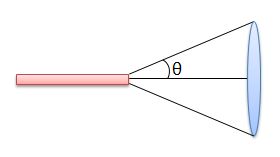
レーザの安全性とクラス分類
レーザを取り扱う際には、安全に関わる器具や装置を適切に取扱い、使用することが重要です。ヒトの目は損傷しやすく、レーザ光のパワーレベルが非常に低い場合でも障害を引き起こします。当社では豊富な種類の安全に関わるアクセサリをご提供しており、そのような事故や負傷のリスクの低減にお使いいただけます。可視域から近赤外域のスペクトルでのレーザ発光がヒトの網膜に損傷を与えうるリスクは極めて高くなります。これはその帯域の光が目の角膜やレンズを透過し、レンズがレーザーエネルギを、網膜上に集束してしまうことがあるためです。
安全な作業および安全に関わるアクセサリ
- クラス3または4のレーザを取り扱う場合は、必ずレーザ用保護メガネを装着してください。
- 当社では、レーザのクラスにかかわらず、安全上無視できないパワーレベルのレーザ光線を取り扱う場合は、ネジ回しなどの金属製の器具が偶然に光の方向を変えて再び目に入ってしまうこともあるので、レーザ用保護メガネを必ずご使用いただくようにお勧めしております。
- 特定の波長に対応するように設計されたレーザ保護眼鏡は、装着者を想定外のレーザ反射から保護するために、レーザ装置付近では常に装着してください。
- レーザ保護眼鏡には、保護機能が有効な波長範囲およびその帯域での最小光学濃度が刻印されています。
- レーザ保護カーテンやレーザー安全保護用布は実験室内での高エネルギーレーザの遮光にご使用いただけます。
- 遮光用マテリアルは、直接光と反射光の両方を実験装置の領域に封じ込めて外に逃しません。
- 当社の筺体システムは、その内部に光学セットアップを収納し、レーザ光を封じ込めて危険性を最小限に抑えます。
- ピグテール付き半導体レーザは、他のファイバに接続、もしくは他のファイバとの接続を外す際には、レーザ出力をOFFにしてください。パワーレベルが10 mW以上の場合には特にご注意ください。
- いかなるビーム光も、テーブルの範囲で終端させる必要があります。また、レーザ使用中には、研究室の扉は必ず閉じていなければなりません。
- レーザ光の高さは、目線の高さに設定しないでください。
- 実験は光学テーブル上で、全てのレーザービームが水平を保って直進するように設定してください。
- ビーム光路の近くで作業する人は、光を反射する不要な装飾品やアクセサリ(指輪、時計など)をはずしてください。
- レンズや他の光学装置が、入射光の一部を、前面や背面で反射する場合がありますのでご注意ください。
- あらゆる作業において、レーザは必要最小限のパワーで動作するようにご留意ください。
- アライメントは、可能な限りレーザの出力パワーを低減して作業を行ってください。
- ビームパワーを抑えるためにビームシャッタや フィルタをお使いください。
- レーザのセットアップの近くや実験室には、適切なレーザ標識やラベルを掲示してください。
- クラス3Rやクラス4のレーザ(安全確保用のインターロックが必要となるレーザーレベルの場合)で作業する場合は、警告灯をご用意ください。
- ビームトラップの代用品としてレーザービュワーカードを使用したりしないでください。
レーザ製品のクラス分け
レーザ製品は、目などの損傷を引き起こす可能性に基づいてクラス分けされています。国際電気標準会議(The International Electrotechnical Commission 「IEC」)は、電気、電子工学技術関連分野の国際規格の策定および普及を行う国際機関で、IEC60825-1は、レーザ製品の安全性を規定するIEC規格です。レーザ製品のクラス分けは下記の通りです
| Class | Description | Warning Label |
|---|---|---|
| 1 | ビーム内観察用の光学機器の使用を含む、通常の条件下での使用において、安全とみなされているクラス。このクラスのレーザ製品は、通常の使用範囲内では、人体被害を及ぼすエネルギーレベルのレーザを発光することがないので、最大許容露光量(MPE)を超えることはありません。このクラス1のレーザ製品には、筐体等を開かない限り、作業者がレーザに露光することがないような、完全に囲われた高出力レーザも含まれます。 |  |
| 1M | クラス1Mのレーザは、安全であるが、望遠鏡や顕微鏡と併用した場合は危険な製品になり得ます。この分類に入る製品からのレーザ光は、直径の大きな光や拡散光を発光し、ビーム径を小さくするために光を集束する光学素子やイメージング用の光学素子を使わない限り、通常はMPEを超えることはありません。しかし、光を再び集光した場合は被害が増大する可能性があるので、このクラスの製品であっても、別の分類となる場合があります。 |  |
| 2 | クラス2のレーザ製品は、その出力が最大1 mWの可視域での連続放射光に限定されます。瞬目反射によって露光が0.25秒までに制限されるので、安全と判断されるクラスです。このクラスの光は、可視域(400~700 nm)に限定されます。 |  |
| 2M | このクラスのレーザ製品のビーム光は、瞬目反射があるので、光学機器を通して見ない限り安全であると分類されています。このクラスは、レーザ光の半径が大きい場合や拡散光にも適用されます。 |  |
| 3R | クラス3Rのレーザ製品は、直接および鏡面反射の観察条件下で危険な可視光および不可視光を発生します。特にレンズ等の光学機器を使用しているときにビームを直接見ると、目が損傷を受ける可能性があります。ビーム内観察が行われなければ、このクラスのレーザ製品は安全とみなされます。このクラスでは、MPE値を超える場合がありますが、被害のリスクレベルが低いクラスです。可視域の連続光のレーザの出力パワーは、このレベルでは5 mWまでとされています。 |  |
| 3B | クラス3Bのレーザは、直接ビームを見た場合に危険なクラスです。拡散反射は通常は有害になることはありませんが、高出力のクラス3Bレーザを使用した場合、有害となる場合もあります。このクラスで装置を安全に操作するには、ビームを直接見る可能性のあるときにレーザ保護眼鏡を装着してください。このクラスのレーザ機器にはキースイッチと安全保護装置を設け、さらにレーザ安全表示を使用し、安全照明がONにならない限りレーザがONにならないようにすることが求められます。Class 3Bの上限に近いパワーを出力するレーザ製品は、やけどを引き起こすおそれもあります。 |  |
| 4 | このクラスのレーザは、皮膚と目の両方に損傷を与える場合があり、これは拡散反射光でも起こりうるとみなされています。このような被害は、ビームが間接的に当たった場合や非鏡面反射でも起こることがあり、艶消し面での反射でも発生することがあります。このレベルのレーザ機器は細心の注意を持って扱われる必要があります。さらに、可燃性の材質を発火させることもあるので、火災のリスクもあるレーザであるとみなされています。クラス4のレーザには、キースイッチと安全保護装置が必要です。 |  |
| 全てのクラス2以上のレーザ機器には、上記が規定する標識以外に、この三角の警告標識が表示されていなければいけません。 |  | |
| Posted Comments: | |
Bill Vignoe
(posted 2024-02-28 15:34:12.407) I have a Glowforge Pro rated at 45W, cat4. What safety glasses should I buy?
Thanks Matthias Pittner
(posted 2024-02-06 09:14:31.547) Dear Thorlabs Support Team,
I have the following request. Is the Laser Security Glass LG11 suitable for the following parameters?
Wavelength: 975 nm
average optical power: 6 W
Beam diameter (1/e²): 74 µm
Beam divergence (half angle): 120 mrad
Full Protection
Wavelength: 1550 nm
average optical power: 400 mW
Pulse repetition rate: 40 kHz
Pulse duration: 2 ns
Pulse peak power: 6 kW
Beam diameter (1/e²): 74 µm
Beam divergence (half angle): 120 mrad
Full Protection
Many thanks and kind regards
Matthias Pittner jdelia
(posted 2024-02-06 11:10:20.0) Thank you for contacting Thorlabs. We unfortunately cannot recommend laser safety glasses for your specific application, but do suggest discussing this with your organization's laser safety officer. We would also encourage you to look at the OD vs Wavelength graph in the overview section of this page. Zbigniew Laszczych
(posted 2024-01-11 14:18:40.983) Hello,
I am looking a pair of LG11A. Do I have to take care of making the corrective lenses myself or you can take the parameters (powers, astigmatism) and provide them with the googles?
Best regards,
Zbigniew Łaszczych jdelia
(posted 2024-01-16 11:06:07.0) Thank you for contacting Thorlabs. If you are referring to prescription lenses to fit the inserts that come with the LG11A, then we do not provide those. I have reached out to you directly to clarify your inquiry. user
(posted 2023-10-25 08:37:41.803) What material are the frames made from? jdelia
(posted 2023-11-13 02:10:42.0) Thank you for contacting Thorlabs. The frames for the LG6 are made out of nylon. user
(posted 2023-07-05 09:43:38.213) Hello!
Could you please help me choose the right laser alignment glasses for working with the following lasers:
420nm, 100 mW, PSU-III-LED, CNI Laser
473 nm, 50 mW, Blue Solid State Laser, MLL473 CNI Laser
532 nm, 50 mW, Blue Solid State Laser, MLL532 CNI Laser
632.8nm, 30 mW, Melles Griot 05-LHP-925, HeNe lasers
640nm, 40 mW, Coherent® OBIS™ 1185054 | LX Laser
I would appreciate quick answer so I can order the glasses asap.
Thank you!
Marko jdelia
(posted 2023-07-05 12:54:06.0) Thank you for contacting Thorlabs. We unfortunately cannot recommend laser safety glasses for your specific application, but do suggest discussing this with your organization's laser safety officer. Helene Bouquerel
(posted 2023-06-08 14:46:57.42) Hello,
I do not understand how to choose the glasses necessary for the 3 LEDs I will use.
It is 3 Thorlabs LEDs : M265L5, M280L6 and M300L4.
Could you help me?
Best regards
Hélène Bouquerel cdolbashian
(posted 2023-06-21 01:02:03.0) Thank you for reaching out to us with this inquiry. Unfortunately, we cannot recommend you glasses for you application, but rather we would advise you to speak to your local laser safety officer regarding this. I would also encourage you to look at the OD vs Wavelength graph in the overview section of this page. Victor Garcia Muñoz
(posted 2022-09-09 14:12:53.32) Hi,
Can you provide the transmisivity for the LG11 and LG16 up to 12 microns.
thanks, Victor user
(posted 2022-09-05 12:47:57.913) In the spec turorial it says: In addition, the lenses and frames must be able to provide the stated level of protection for 10 seconds or 100 pulses depending on the mode of the laser.
Does this mean, that if I use a pulsed laser pulsing at 80MHz, the glasses protect me against a direct beam only for 1/80MHz*100 seconds? jdelia
(posted 2022-09-07 01:14:29.0) Thank you for contacting Thorlabs. Yes, you are correct. In this case that would equate to 1.25 microseconds. Kevin Kaw
(posted 2022-08-08 12:40:18.237) Can we have the "Laser Glasses Selection Guide" figure in linear scale instead of logarithmic? Figure is in the overview tab. This makes it very easy to compare based on what we need. cdolbashian
(posted 2022-08-15 03:16:45.0) Thank you for reaching out to us Kevin. At this time we only have this data available as a logarithmic presentation. I have reached out to you to discuss your confusion and your particular application. Émile Jetzer
(posted 2022-08-02 14:26:51.3) Hi; I'd like to know if it is possible to get the inserts on their own so the glasses can be used by several people with different prescriptions. Thanks! jdelia
(posted 2022-08-03 04:22:12.0) Thank you for contacting Thorlabs. I have reached out to you directly to discuss the possibility of quoting these out to you. P. Kucirek
(posted 2022-07-25 15:16:07.14) Hi,
the frame of our LG11A broke - is it possible to get a new frame/replace it ourself?
Best regards jdelia
(posted 2022-07-28 02:45:13.0) Thank you for contacting Thorlabs. I have reached out you directly regarding the feasibility of ordering just the frames of our LG11A glasses. user
(posted 2022-06-23 19:54:25.85) These were so unsafe and I could visibly see exposure in the top and bottom of the glass jdelia
(posted 2022-07-05 03:47:20.0) Thank you for your feedback. I have reached out to you directly to clarify the specifics of your experience! I hope to hear from you soon. OTHMAN MOHSEN
(posted 2022-06-21 15:24:07.307) Can you please send me your Quotation of those
1. wavelength Range (nm) 630-655, THORLABS Range/optical Density(OD) 625 to 850 nm OD= 4+, Typical Wavelength = 633 nm.
2. wavelength Range (nm) 630-655, THORLABS Range/optical Density(OD) 625 to 850 nm OD= 4+, Typical Wavelength = 650 nm.
3. THORLABS Range/optical Density(OD) 190 to 534 nm OD= 7+, Typical Wavelength = 532 nm.
4. wavelength Range (nm) 750-1000, THORLABS Range/optical Density(OD) >740 to 1070 nm OD= 7+, Typical Wavelength = 760 -930 nm.
Thank you. jdelia
(posted 2022-06-21 11:41:04.0) Thank you for contacting Thorlabs. Our laser glasses selection and the OD specs of each of our models can be found on the product family page here: https://www.thorlabs.com/newgrouppage9.cfm?objectgroup_id=762. Once you decide which ones best fit your needs, you can request a quote either directly on the website, or by contacting our sales team at either 973-300-3000 or sales@thorlabs.com. Please direct future quote inquiries to our sales team as well. Frans Segerink
(posted 2022-03-22 10:15:46.597) Dear Thorlabs,
We have goggles over the age of 10 years, which have increasingly sticky frames. As the optical part is still ok, I would lik to buy a few frames without optics, so I can repair my sticky ones, which nobody wants to use anymore.
Your response is appreciated.
Frans. jdelia
(posted 2022-03-23 09:58:42.0) Thank you for contacting Thorlabs. We will be reaching out to you directly to discuss buying new frames for your laser goggles. user
(posted 2022-01-07 05:42:55.19) Hello,
I would need a pair of laser safety glasses because during my job I have to work with a fiber laser cutting machine with a class 4 semiconductor diode laser source. The laser source has the following characteristics:
MAX AVERAGE OUTPUT POWER 2kW CW
WAVELENGHT RANGE 900-1200 nm.
The supplier of the machine recommended us glasses with the following characteristics:
190-400nm + 750-1120nm OD 6+
800-1100nm OD 7+ 37%VLT YG4
750-800 +> 1100-1120 DIR LB6 +M LB6Y
>800-1100 D LB6 + IR LB7 + M LB7Y
180-315 D LB7 + IR LB4 NOIR
Is the supplier's recommendation correct? Do you have a model of glasses suitable for our needs?
Thank you in advance. cdolbashian
(posted 2022-01-07 09:31:24.0) Thank you for reaching out to us at Thorlabs. While Thorlabs cannot formally recommend specific laser safety glasses, we suggest checking on the suitability of the LG11 for your application with your local Laser Safety Officer since it has an OD spec of 7+ for both wavelengths of interest. user
(posted 2021-12-09 05:11:02.6) Hello, i would appreciate some advice on laser safety goggles. I have general safety ones but am considering what i additionally need for alignment so that i can safely use to align a full power beam. We have two lasers (CW), one is 473 nm (20 mW output) and the other 785 nm (100 mW).
thanks
tina YLohia
(posted 2021-12-10 02:21:10.0) Hello Tina, thank you for contacting Thorlabs. While Thorlabs cannot formally recommend specific laser safety glasses, we suggest checking on the suitability of the LG12 for your application with your local Laser Safety Officer since it has an OD spec of 7+ for both wavelengths of interest. jianbin li
(posted 2021-09-13 21:28:30.867) ">950 to 1080 nm (D LB6 + IRM LB7b)"里最后的b是什么意思?
What does the last "b" mean in ">950 to 1080 nm (D LB6 + IRM LB7b)"? YLohia
(posted 2021-09-17 05:02:23.0) The "b" refers to the footnote "b" right below the spec table: "For the M rating of LB7 in the wavelength range of >950 to 1064 nm, the glasses were tested at pulses between 12 ps and 170 fs." user
(posted 2021-09-02 10:28:08.03) Hello,
We use the Spectra-Physics MaiTai DeepSee 1040 D8 Class IV laser (690-1040 nm). Which laser safety glasses do you recommend with this laser?
Thank you!
Sarah YLohia
(posted 2021-09-03 08:31:32.0) Hello Sarah, thank you for contacting Thorlabs. We recommend selecting the highest possible optical density (OD) for the wavelengths you need to block. Unfortunately, we don't offer anything with an extremely high OD for your entire wavelength range. The LG12 will offer you the highest OD (3+) from our catalog for your range. Please confirm the selection with your local laser safety officer before purchase as we are not liable to make formal laser safety recommendations. David Gay
(posted 2021-05-19 15:09:22.47) We purchased three LG11 laser safety glasses around 2014. We used them occasionally and they were mostly kept in their cases. I recently discovered that the sheath on the temples of the glasses, made of flexible polymer, became very sticky and oily. Since the filters and spectacle frames are like new, we would like to change the sheath only.
Do you sell the sheath separately? If so, what would be the part number and the price of 8 sheaths.
Thank you. YLohia
(posted 2021-05-20 10:30:31.0) Hello, I have reached out to you directly to discuss the possibility of offering this. Tobias Utikal
(posted 2021-01-28 09:46:04.067) Hi Thorlabs, it would be nice to have a tool where I plug in my laser parameters and it suggests the correct glasses. YLohia
(posted 2021-01-28 10:29:51.0) Hello, thank you for your valuable feedback. We will consider adding such a feature on the website. Bart Malfait
(posted 2020-10-15 07:43:49.08) How can we desinfect the laser glasses (Covid) without damaging them. This would happen every time somebody would use them. llamb
(posted 2020-10-20 11:12:05.0) Thank you for contacting Thorlabs. For disinfection of the glasses, we recommend mild detergent or soap and hot water or a dilution of isopropyl alcohol (up to 70% solution). We do not recommend any highly caustic solutions. The laser safety rating will not be affected by any of the above cleaning procedures. Di Chang
(posted 2020-08-18 20:58:37.8) How long the warranty is for this goggle?
We bought two about a year ago and they both have cracks around the edge which is very unsafe to use because that gives a gap between the lens and the edge so that laser can get in. YLohia
(posted 2020-08-19 10:37:38.0) Thank you for contacting Thorlabs. We are sorry to hear about the issues you are having with your LG11A. The warranty information can be found on the product page (https://www.thorlabs.com/thorproduct.cfm?partnumber=LG11A). I have reached out to you directly to discuss this further. Michael Shirk
(posted 2020-07-10 14:35:24.047) Hey Friends
I don't wear prescription glasses, but do require reading glasses (that can be purchased for about $5 a pair from Amazon). Do you think you would consider stocking standard lens inserts with common reading glasses prescriptions for this line of goggles? It would save everyone money and I am sure that you could sell many of them. llamb
(posted 2020-07-13 02:29:02.0) Thank you for your feedback. We will consider your suggestion further. For the time being, our Universal style frames can be worn over prescription (or reading) glasses and could be an alternative. 鸿州 张
(posted 2020-06-09 15:26:38.243) 请问这款LG11A激光安全眼睛能戴近视眼睛使用吗? YLohia
(posted 2020-06-09 11:13:39.0) Thank you for contacting Thorlabs. An applications engineer from our team in China (techsupport-cn@thorlabs.com) will reach out to you directly. Boon Heng Ng
(posted 2020-05-18 10:36:30.993) Hi,
I am operating tool with Class 4 laser (infra-red) with Optical Density of OD>6.43 for 1060nm-1070 nm (infra-red), please advise which type of safety glass (Universal Style type) is recommended for this laser wave length.
Thank you.
Regards,
Boon YLohia
(posted 2020-05-18 10:45:47.0) Hello Boon, thank you for contacting Thorlabs. We recommend selecting the highest possible optical density (OD) for the wavelengths you need to block. The LG11 will offer you the highest OD (7+) for your 1060 nm - 1070 nm range.
Please confirm the selection with your local laser safety officer before purchase. Joan Martí González
(posted 2019-11-19 08:53:16.45) Hello,
My question is about if these model, LG16C, is suitable for working with a 40 W Class IV CO2 Laser engraver, which wavelength is 10640 nm. I supose it is, but in the specifications it only says that the OD 6+ is until 10600 nm, and does not specify anything for greater wavelengths.
Thank you very much. YLohia
(posted 2019-12-09 10:30:24.0) Hello Joan, thank you for contacting Thorlabs. May I ask if there is any particular reason for not considering the LG6C glass instead? It has OD 7+ from 9,000 to 11,000 nm. I had reached out to you directly to discuss this further but did not hear back. Ethan He
(posted 2019-05-21 10:58:18.23) Hi, we need glasses to have these specifications:
Optical density: 512-532nm OD>=9
security value: 515-532nm D LB8 + IR LB9 + M LB9Y
Daylight transmittance:20%
Filter color: Orange
Glas-filter(coated)
Do you have these kind of glasses? Thanks! YLohia
(posted 2019-05-21 09:18:00.0) Hello, thank you for contacting Thorlabs. Unfortunately, we do not offer anything at the moment that matches these specs exactly. The closest option from our catalog would be the LG12. Fabrizio Orlando
(posted 2019-05-20 08:25:34.717) Hello, I am looking for laser safety glasses for the following lasers:
(1) 635 nm, 5 mW, CW, beam diameter: 0.9 mm
(2) 1152 nm, 5 mW, CW, beam diameter: 0.9 mm
(3) 3392 nm, 5 mW, CW, beam diameter: 1.55 mm
According to your specs tutorial, I would need a LB1 for the 635 nm and 1152 nm lasers, and a LB3 for the 3392 nm laser. Could you please advise on that? Which laser safety glass(es) models would be appropriate?
Thanks,
Fabrizio YLohia
(posted 2019-05-20 10:57:51.0) Hello, we recommend selecting the highest possible optical density (OD) for the wavelengths you need to block. Your current selections offer minimal OD at your operating wavelengths.
(1) 635 nm: LG4 (OD 4+)
(2) 1152 nm: LG11 (OD 7+)
(3) 3392 nm: LG11 (OD 5+)
Please confirm all selections with your local laser safety officer before purchase. alex.jones
(posted 2019-01-11 11:40:32.467) I have an Insight X3 with frequency doubler, which cover 340-650 and 680-1300 nm. Could you please advise about suitable laser safety specs?
Thanks,
Alex YLohia
(posted 2019-01-11 04:11:48.0) Hello Alex, thank you for contacting Thorlabs. For a single item, the LG1 offers the highest optical density for all of the wavelengths in your two ranges. Please note that the OD in the 680-800nm range is relatively low. I will reach out to you directly to discuss this further. albert.romann
(posted 2018-08-29 08:13:06.707) Hi there
Do you sell detachable inserts for prescription lenses separately? (comfort style frame)
Cheers,
Albert llamb
(posted 2018-08-31 03:04:10.0) Hi Albert, thank you for contacting Thorlabs. For future reference, please contact techsupport@thorlabs.com for quotes on custom/special products. We can indeed offer these detachable inserts as non-standard items. We will reach out to you by email to discuss a custom quote. rezaya
(posted 2018-04-02 10:43:42.97) Hi,
I'd be using "Nano S 30-30 PIV" laser with these specifications:
Wavelength: 532 nm
Energy per pulse: 30 mJ
Pulse width: 8 ns
Pulse repetition frequency: 0-30 Hz
Based on an online calculator that used the min OD required is 5.59. Could you please help me know which other parameters should I consider for choosing the right goggles? Suggestions in choosing the goggles would be greatly appreciated.
Best,
Reza llamb
(posted 2018-04-03 03:45:17.0) Hello Reza, thank you for contacting Thorlabs. Our LG3-, LG10-, or LG12- series glasses offer an Optical Density >7 at 532 nm, though I would recommend discussing your needs with your local laser safety officer to be safest. I will reach out to you directly as well. kz
(posted 2018-03-27 10:28:09.523) Hello:
I am building a laser system with IR 1064 nm laser, 20W output, pulsed, with pulse length about 33 ns, 0.7mJ maximum energy in one pulse. I estimated that LG1 goggles are the correct ones to use with this type of laser. Could you, please, confirm it for me? Thank you in advance for your help!
Kirill llamb
(posted 2018-03-30 04:09:10.0) Hello Kirill, thank you for contacting Thorlabs. I recommend discussing your safety glasses selection with your local laser safety officer who can most effectively evaluate your laser specs. Our LG1 glasses have an Optical Density >7 at 1064 nm and are among our cheaper options for laser safety glasses. I will reach out to you directly as well. panagiotis.bilalis
(posted 2017-10-25 23:57:19.68) Hello, I need laser safety glasses for 632.8 nm light with OD=2. Could you please help me to pick the right ones? Thanks in advance! tfrisch
(posted 2017-10-30 11:29:50.0) Hello, thank you for contacting Thorlabs. For liability reasons, please verify all laser goggle selections with your local laser safety office who would have access to the complete specs of your laser. LG4 and LG7 series each have an OD >2 at 632.8nm, so I will reach out to you directly to discuss them. felix.hofmann
(posted 2017-09-19 09:16:04.263) Hi, I need laser safety glasses that give LB6 at both 532 nm and 560 nm. I don't seem to be able to find anything with suitable specification on your website. Can you help? Thanks, Felix tfrisch
(posted 2017-09-26 05:09:17.0) Hello, thank you for contacting Thorlabs. I will reach out to you directly about your custom needs. maws
(posted 2017-07-31 11:29:16.427) Our lab. owns a confocal microscope which is equipped with the following lasers:
Class 3B:
a)diode solid state 405 nm
b)argon (458 nm, 488 nm, 514 nm)
c)DPSS 561 nm
d)helium neon 633 nm
Class 4:
coherent ultra 2
Ti: Sapphire 680-1080 nm
Please advise which laser protective eyewear models will be appropriate for the above laser protection. Thanks for your kind help.
Victor Ma
Medical Technologist tfrisch
(posted 2017-08-16 10:27:07.0) Hello, thank you for contacting Thorlabs. We will reach out to you with some recommendations for laser safety goggles from your various lasers, but it is always best to check with your local laser safety officer before making a final decision. robert.kakonyi
(posted 2017-05-02 14:28:23.893) Dear Support,
Just a note/improvement proposal:
Do you have a selection tool for Laser Safety Glasses?
I mean I set the desired wavelength and laser parameters, and the page orders them in OD number, pass/fail criterion.
Prio: low.
Thanks,
Róbert tfrisch
(posted 2017-05-02 12:58:07.0) Hello, thank you for contacting Thorlabs. It is necessary to confirm that laser safety goggles meet the requirements of your laser safety officer on site. If you need help understanding the ANSI Z136, EN 207, or EN208 standards on the Specs Tutorial tab, our Tech Support team would be able to discuss those with you. I will reach out to you directly about this application. randy.hurd
(posted 2017-04-13 18:28:23.227) I have a pair that has formed a crack running from the frame at the top of the lens into the lens rendering them unusable. Is this a warranty issue? tfrisch
(posted 2017-04-27 04:48:19.0) Hello, thank you for contacting Thorlabs. I will reach out to you directly about the damage to these goggles. eric.washburn
(posted 2017-02-15 08:46:11.79) I need glasses that will be appropriate for use with both Ti:sapphire and Insight lasers with wavelengths of 680-1300 nm.
thanks
eric tfrisch
(posted 2017-02-16 03:24:48.0) Hello, thank you for contacting Thorlabs. I will reach out to you directly about your laser specs. cpepe
(posted 2016-11-28 05:55:25.953) Hello,
I need laser safety glasses for 532 nm light. I have looked at LG12 and LG3 that both have OD = 7+.
However I want to make sure I understood your L-rating correctly: LG12 has LB5 and LG3 has LB6 for 532 nm continous (D) light. Therefore is it correct that I can use a max laser powerdensity of 10^6 W/m^2 with LG12 and 10^7 W/m^2 with LG3?
Thanks in advance! tfrisch
(posted 2016-11-30 10:40:56.0) Hello, thank you for contacting Thorlabs. I will contact you directly to discuss the specs you have listed above. You should also have the purchase of laser safety goggles approved by your laser safety officer to be sure they comply with all policies for your lab. kedves
(posted 2016-11-11 15:01:23.68) Dear Thorlabs,
we need safety glasses for Ti:Sapphire amplifier alignment. We would need about OD 3-4 around 532 nm for attenuating the pump beam and OD>7 above 750 nm to block the fs pulses. It would be similar to LG12 with the difference that the OD is lower around 532 nm. I have not found such a product in your list; can you offer this version too? Thanks tfrisch
(posted 2016-11-11 04:27:36.0) Hello, thank you for contacting Thorlabs. I will reach out to you directly about the needs for your application. cpepe
(posted 2016-11-11 06:18:19.993) Hi,
I was wondering what is your definition (in wavelenght) of visible when it says 59% visible light transmission at what wavelenght is this? tfrisch
(posted 2016-11-16 08:47:19.0) Hello, thank you for contacting Thorlabs. The function that defines the visible light transmission is weighted by the sensitivity of the human eye which is governed by ANSI and EU standards. I have emailed you directly. dokumentydokumenty
(posted 2016-06-22 22:59:40.323) Hello
And against INFRARED ?Please....?You have something against infrared?
Thank you
Adam besembeson
(posted 2016-06-23 03:45:22.0) Response from Bweh at Thorlabs USA: Yes we do offer several laser safety glasses for infrared wavelengths as can be found here: http://www.thorlabs.com/NewGroupPage9.cfm?ObjectGroup_ID=762 cbrideau
(posted 2016-04-21 20:16:28.42) Just want to add my voice to all the people asking for LG11 in a proper universal style frame. It has the best visible light transmission for working with NIR lasers. It is very disappointing that it is not available in a style that works over regular glasses. Please pressure your supplier to offer this in a better form factor for folks with prescription glasses! besembeson
(posted 2016-04-22 08:36:10.0) Response from Bweh at Thorlabs USA: The LG11 has a different frame style because at this time, it is difficult to cut the glass that is used to the shapes that fit the universal frames. However, according to our tests, these actually fit over most prescription glasses, but it is not as comfortable as the other universal frames that we have. We will look into improving the frame design to be more in line with the standard universal frames. sebastian.jaeger
(posted 2015-09-23 12:14:20.73) Dear Sir or Madame, I'm confused regarding the CE certification of your laser safety glasses. You are using the incorrect CE symbol on your webpage leading towards that I'm not allowed to buy your laser safety glasses. The symbol you use here is commonly referred to as "chinese export" and is usually used on very cheap and unsafe products. If your glasses are really CE certified, please use the correct symbol. Kind regards, Sebastian Jäger myanakas
(posted 2015-09-23 04:16:36.0) Response from Mike at Thorlabs: Thank you for your feedback. This has been corrected and we apologize for any inconvenience that this may have caused. Our laser glasses are CE certified and the certification can be found by clicking on the red “Docs” icon next to the item numbers. ylai
(posted 2014-12-11 20:51:47.003) Dear Thorlabs,
I am a graduate student in Caltech. Our group would like to purchase your LG11 product. However, do you have universal style frame for this product? Could you customize that? It would be very convenient for our group to use these goggles.
Best,
Yu-Hung Lai
Applied Physics
California Institute of Technology jlow
(posted 2014-12-18 03:58:49.0) Response from Jeremy at Thorlabs: The LG11 lens is more difficult to cut than the other ones and they are not available in the universal style. We can provide other styles which might work for you. I will contact you directly to discuss about this further makarov
(posted 2014-09-18 18:18:31.71) LG11, unlike all other Thorlabs glass models, have a different and very bad frame design. They do NOT fit over male-sized prescription glasses (despite beind advertised to do so!) and they fall off my head every time I move around. The hooks are plastic and cannot be bent to grip my ears better. The frame design of other Thorlabs glasses does not have such problems; as far as I can tell LG11 is the only different frame model. myanakas
(posted 2014-09-30 11:16:05.0) Response from Mike at Thorlabs: Thank you for your feedback. We apologize for the inconvenience that this discrepancy in frame styles has caused. Based on your feedback we have updated the web and spec sheets for the LG11 safety glassed to reflect that they do not work with prescription glasses. blanch
(posted 2014-08-12 15:32:35.537) We are interested in blocking both UV and IR light over 800 nm. We use a setup with 8 strong halogen lights (generally Paulmann, 35 W and 12V at 2900 K color temperature or also IR halogen lights).
In terms of spectral filtering LG2 seems to do the job but could it be that the visibility is too reduced? Normally we work on a dark room with a setup where 6 to 8 halogen lights are placed on a small frame. We need to see enough to manipulate the samples under the lights and look at a computer screen.
Would the LG2(19%VLT) be suitable for the task or would you rather advice the LG11 (75%VLT) or another type?
Thanks in advance for your time,
Carolina jlow
(posted 2014-08-13 08:52:35.0) Response from Jeremy at Tholrabs: We will contact you directly to discuss more about your application and suggest appropriate goggles. necmettinkenar
(posted 2014-06-23 12:38:44.34) Dear Sir/Lady
We have recently purchased laser Safety Glasses (LG-10) with
Invoice Number : 1793305
Sales Order: TS1187311
We are to get the products purchased,
we need CE sertification sheet of LG10 - Laser Safety Glasses
for customs office.
In case we havent give the requested document to our Customs office we wouldnt get
the safaty glasses,
Thank you for your kind support,
Best Regards, myanakas
(posted 2014-07-07 10:31:44.0) Response from Mike at Thorlabs: Thank you for your feedback. We are currently getting this information together and added to our website in the next couple of days. I have emailed you directly with the LG10 CE certificate. user
(posted 2014-02-27 21:54:42.847) Dear Thorlabs,
we are using yellow lasers for optogenetics in our lab. You don't seem to have goggles in your catalog which protect against yellow light (590 nm). Currently we just use the blue goggles as a better-than-nothing solution, but it would be great to get a model with yellow absorption.
Best,
Michael jlow
(posted 2014-02-27 04:25:44.0) Response from Jeremy at Thorlabs: We will look into carrying this as a regular stock item. We can offer this as a custom now. Since you did not leave your contact info, can you e-mail techsupport@thorlabs.com to request a quote please? artetampo
(posted 2014-01-22 12:00:30.133) Buenos dias tengo un laser de fibra que tiene clase 4 invisible radiacion, longitud de onda de 1040-1200 nm, y clase 3R laser visible de longitud de onda de 630-670 nm, quisiera saber que referencia de gafas necesitaria para este laser.
gracias ATTE. Javier Tovar jlow
(posted 2014-01-22 02:30:39.0) Response from Jeremy at Thorlabs: The selection of laser safety goggles should also take into account the diameter of your laser and the operating mode. We will contact you directly to find out more about the specifications of your laser and suggest something appropriate. cpinyan
(posted 2013-11-06 16:08:06.487) Make interactive graph function so we can chosse start and end wavelength and select different combination of goggles - would let user confirm they have covered a particular range.
And - a grid showing OD of each goggle for certain common laser lines - would make selction faster than scrolling back and forth among the charts (or downloading the graphs).
Ex 370, 488, 532, 633, 780, 980, 1064, 10.6um sharrell
(posted 2013-11-12 07:52:22.0) Response from Sean at Thorlabs: Thank you for your feedback on our website. The website team has discussed the possibility of making "interactive graphs" as you suggest. In the meantime, we offer downloadable data in Excel format for many of our products, including our laser safety glasses. The data may be found at the bottom of the "OD Specs" column of the tables above each ordering area below. For your second comment, we had a graphical chart in our most recent catalog that I believe would aid in the selection process. I will get this added to the website this week and send you a pdf of this via email. user
(posted 2013-07-03 09:50:14.423) How can i clean the lenses of LG10 safety glasses? cdaly
(posted 2013-07-03 10:20:00.0) Response from Chris at Thorlabs: Thank you for using our feedback tool. The laser safety glasses can be cleaned using 91% isopropyl alcohol and wiped with a cotton swab. junghyup
(posted 2013-03-13 18:20:54.85) what is the width of these laser safety glasses?
And what glasses do I need to choose for my 561 nm green laser? tcohen
(posted 2013-03-14 13:20:00.0) Response from Tim at Thorlabs: The dimensions for each laser safety glasses can be found in the spec sheet. The interior is 145mm x 53mm and have a 140mm temple. The diagonal of the lenses is 68mm. In most cases, we would chose based on the description I provided earlier in the feedback tab and using our “Specs Tutorial” tab. However, in your case the wavelength falls outside our specified ranges. We can supply some custom glasses and will need to discuss your laser output to provide a solution. heather.duschl
(posted 2013-02-01 13:20:32.32) My lab is looking for a laser safety goggle solution for a super-continuum laser. Would it be possible to get custom glasses that block all light above a wavelength of 400nm? jlow
(posted 2013-02-06 16:36:00.0) Response from Jeremy at Thorlabs: We do not have any safety goggles that block all the visible light. I will get in contact with you directly to discuss about this further. tcohen
(posted 2013-01-10 10:28:00.0) Response from Tim at Thorlabs: Thank you for contacting us. You can determine appropriate safety goggles through the European EN 207 standard. Determine the power density, wavelength and mode you will be working with. Assuming you are working with a 2mm beam diameter at 100mW, 473nm and 593nm, both CW, these fall under the same calculation class. Please see the “Specs Tutorial” for a description of this calculation. Assuming the parameters above, you would be looking for a minimum L rating of D(CW laser) LB4 for both 473nm and 593nm. Since these wavelengths fall right in the middle of visible, it may be more appropriate to choose two goggles to keep your visible light transmission higher if not using the sources simultaneously. Please contact us and consult with your laser safety officer if you have any questions. mv780
(posted 2012-12-19 15:36:08.437) Hi, I was wondering which glasses you would advice for use for 100mW 473nm DPSS and 100mW 593nm DPSS lasers?
Thanks tcohen
(posted 2012-07-18 10:31:00.0) Response from Tim at Thorlabs: Thank you for contacting us! We will need to discuss your OD requirements. I will contact you directly to determine if we can provide a custom that suits your source. mathieu.maisonneuve
(posted 2012-07-16 14:42:49.0) Are you doing custom glasses for supercontinuum use. I got a fianium supercontinuum laser and I want to block all light after 550nm (range of laser 550 - 2500nm) ! Thanks. sharrell
(posted 2012-04-18 15:29:00.0) Response from Sean at Thorlabs: Thank you for your feedback. I’m sorry you had a hard time reading our plot. I've sent you an Exel file with the LG6 data directly. For the LG6, there is a steep slope between 400 and 500 nm which will make the value at 455 nm difficult to determine, but from the values on the plot, it is approximately OD = 3. We recommend discussing the choice of laser safety glasses with your laser safety officer.
We will be adding downloadable data files as well as easier to read plots to our website soon. phila
(posted 2012-04-18 10:38:02.0) Could I please get a more detailed OD vs lambda plot? What is OD at 455 nm? bdada
(posted 2012-03-15 10:58:00.0) Response from Buki at Thorlabs to utsavdeepak.dave:
Thank you for participating in our feedback forum. To get more detailed information from the OD graphs, please click the "zoom" hyperlink at the bottom of the graph. The information from each graph is corroborated by the specifications table next to the graph. For your 445nm laser, we have several options that provide an OD greater than 3. For example, LG2 has an OD of 6+, while LG3 and LG10 have an OD of 7+.
Please note that we provide an OD to transmission conversion table in the "Overview" section on this webpage.
For a 1W laser, we highly recommend you discuss your laser safety requirements with your laser safety officer to ensure you purchase the appropriate goggles.
Please contact TechSupport@thorlabs.com if you have any questions. utsavdeepak.dave
(posted 2012-03-12 10:09:16.0) Hello, I wish to know which product would be most suited for a class 4 laser (blue, 445nm, 1W total optical output) such that its possible to view the laser safely. I suppose OD~3.3 is required at this wavelength. Are there any products that match up to this requirement? Some of the products listed on the website seem to match up but in those products, the OD curves are sloping at this wavelength and in the others where it is constant, the value is either too high or low.
Hence please notify if there are glasses available with OD~3.3 or thereabouts @ 445 nm.
Thank you. anthony.marriott
(posted 2012-02-13 11:56:20.0) I need a pair of safety glasses to cover 670nm 5mW, 639 30mW and 780nm 50mW CW laser diodes if that is possible with a single pair. They would be used for viewing beam during alignment, but not directly looking at beam. mainly used to protect engineers in reflected light. I'm not sure what pair to select, the LG4 covers the range but would they cut out to much light for teh low powered diode to be visable? bdada
(posted 2012-02-02 20:16:00.0) Response from Buki at Thorlabs:
Thank you for participating in our feedback forum. The LG2, LG3, and LG10 all provide you with an OD of 6+ or better at 405nm, so it would be a matter of preference how much visible light transmission you need to ensure appropriate visibility while you wear the goggles.
Please contact TechSupport@thorlabs.com if you have further questions or concerns about choosing the laser goggles best suited for your application. murali.samiyappan
(posted 2012-01-30 22:51:39.0) I am planning to purchase goggles for blue laser 405nm wavelength & OD 6+. Which would you recommend among LG2(19%VLT), LG3(48%VLT) and LG10(35%VLT)? Would a higher VLT percentage be considered better or otherwise? bdada
(posted 2012-01-12 20:55:00.0) Response from Buki at Thorlabs:
An OD of 6+ is a transmission of 0.0001%. We have an OD to % transmission table on the web page that should help you determine how much light will be transmitted through the goggles. The LG2 goggles you referenced permit 19% visible light transmission. If you are concerned about seeing your 405nm beam during alignment, please consider one of our viewing cards like the VRC1. I have included a link to our viewing cards below. Please contact TechSupport@thorlabs.com if you have any questions. jessie.r.weber
(posted 2012-01-12 11:12:07.0) which goggles would you recommend for 100mW (0.7mm diameter) 405nm laser alignment? would the L2 (OD of 6+ @ 405) be transmissive enough to see the beam? thank you! bdada
(posted 2011-09-21 14:52:00.0) Response from Buki at Thorlabs:
The right type of goggles would depend highly on the environmental condition (i.e. intensity of backlighting), whether you are looking straight into the beam or looking at reflections, the object from which the beam reflects.
We have contacted you to discuss different options from our selection of laser goggles, but please note that you should reveiw the specifications of the goggles with your laser safety officer to determine the appropriate one for your application. yvan.quintal
(posted 2011-09-05 12:11:28.0) Hi,
I am using a Bosch Laser distance measurer model GLR 225. It is a laser class 2, Laser diode 635 nm, smaller than 1 mw. Measuring time max: 4 sec, measuring time type: smaller than 0,5 sec. Wich model of safety glasses I may buy to protect my eyes and aalso be able to see correctly the read beam(without looking in directly on it)line and having a good visibilty of the objects arounf while working?
Regards,
Yvan
cel: 514-238-9059 jjurado
(posted 2011-02-28 09:37:00.0) Response from Javier at Thorlabs to nirmal.virdee: Thank you very much for contacting us with your request. The LG2 glasses should provide enough eye protection for your experiment. They are specified with an optical density value of 3 in the range of 820-1720 nm, which corresponds to a transmission value of 0.1%. So, at 20 dBm, or 100 mW, only a small fraction of light will be transmitted through the glasses (100 uW), which constitutes no harm for the eye. Keep in mind that this is assuming a focused or collimated laser; however, if we factor in the divergence from the tip of the fiber, the actual incident light onto the glasses will be much less. nirmal.virdee
(posted 2011-02-25 20:33:27.0) I have a group that is working on DWDM fiber optic equipment, including EDFA amplifiers, that have output levels of about 20dBm on single mode fiber (9um core). These operate in the C-band, 1528nm - 1565nm. I need to buy safety glasses for the engineers but cannot determine which one is the right one. Can you please let me know which one is the right one and why? I was thinking LG2 but its level of protection does not seem sufficient. Maybe I am not calculating it correctly. Thanks, Nirmal.Virdee@adtran.com. jjurado
(posted 2011-02-18 09:25:00.0) Response from Javier at Thorlabs to pillippe.rondeau: Thank you very much for submitting your feedback. The current EN 207 L ratings are still valid. We are currently in the process of re-certifying all of our laser safety glasses. Once all have been re-tested and re-certified to the LB-ratings (the test conditions changed slightly, and in some cases the current ratings will increase and the covered wavelength ranges will broaden), we will present new specifications printed on the lenses of laser glasses and and new support documentation. If you require LB-rating documentation, we may be able to provide a preliminary copy. philippe.rondeau
(posted 2011-02-17 06:17:08.0) EN 207 standard has been modified (from june 2010)and induces new tests and marking of the laser safety glasses : could you provide informations concerning the compliance of these safety glasses with the new standard jjurado
(posted 2011-02-03 11:36:00.0) Response from Javier at Thorlabs to ozieseniss: Thank you very much for submitting your inquiry. Actually, any of our LG series laser safety glasses would work well for eye protection in the 180-320 nm range. If you refer to the OD Specs chart, you will see that the optical density of all of the LG glasses falls in the 5 to 7 OD value in the 190 to ~400 nm range. This translates into transmission values of 0.001% to 0.00001% (you can visit the Specs Tutorial tab for more info). If 180-320 nm is the only wavelength of concern, then we would suggest using our LG6 glasses, which have an OD of 7 in the range of 190-398 nm. Please note that we stronly recommend having your lab safety technician review the specifications of these glasses before they are used in your experiment. I will contact you directly in case you have further questions. ozieseniss
(posted 2011-02-02 17:44:07.0) Dear Thorlabs Team,
Im looking for safety glasses that cover the spectrum of concern for biological safety and health in the 180-320 nm range.
The UVC radiation system we are using for surface disinfection has a high irradiation intensity of 70 mW/cm² at 254 nm (in a 2 cm distance from the quartz glass plate).
So, Im looking for something that actually covers the 254 nm range....what do you recommend?
Thanks Adam
(posted 2010-04-28 13:45:17.0) A response from Adam at THorlabs: We currently do not sell one set of glasses that will block 1064nm, 694nm and 532nm effectively. We can provide the LG10 glass, which will block the 1064nm and the 532nm light. To block the 694nm light, I would recommend the LG7. We may be able to offer a custom version that may cover all of your wavelengths. Please email techsupport@thorlabs.com if you are interested in a custom option. Please note that we always recommend reviewing these items with a safety officer at your company before purchasing them. user
(posted 2010-04-28 12:06:33.0) I need protection for 1064nm, 694nm, and 532nm...what do you recommend? Adam
(posted 2010-04-13 08:58:17.0) A response from Adam at Thorlabs to mozaffari: The glasses we currently provide that will block light at 532nm are the LG10 and LG3. The LG10 will block light from 190nm-534nm with an OD of 7+, while the LG3 will block light from 190nm-532nm with an OD of 7+. mozaffari
(posted 2010-04-13 01:56:40.0) I need protection from 532 nm in addition to the spec, any solutuon? Thanks klee
(posted 2009-11-20 15:58:10.0) A response from Ken at Thorlabs to marcoc: The L-rating for the LG9 is L5 for 720-1075 nm. We may be able to provide a custom goggle. Please send your requirements to techsupport@thorlabs.com so that we can work on a quotation for you. marcoc
(posted 2009-11-19 16:56:00.0) Hi,
Can you provide the ratings of LG9 for mode lock laser ?
I would like to use LG3 for second and third harmonic generation (starting with 800nm, fs laser).
The problem is that LG3 doesnt stop the fundamental. Would you think its possible to add a coating to reflect 750-850nm ?
Can you provide custom made combination ?
In this case can I send you table of glasses needed ?
thanks,
marco jens
(posted 2009-06-04 08:08:35.0) A reply from Jens at Thorlabs: we can offer a custom solution for this combination. I will send you the details for that. olsonaj
(posted 2009-06-03 16:48:31.0) Hello. I am interested in glasses that have OD 3+ at 780nm and OD 7+ at 1550nm. I didnt see any of yours listed as having those properties. Can ThorLabs combine two lenses to create such glasses? Laurie
(posted 2009-04-13 08:18:26.0) Response from Laurie at Thorlabs to aidi: We would recommend the LG4 blue lens, which has an optical density that is >5 for both 633 nm and 780 nm light. The LG4 goggles are ANSI Z136 compliant. aidi
(posted 2009-04-08 23:11:50.0) Could you suggest which glass is suitable for working free-space optic setup with 780nm laser diode and 633nm HeNe laser application and also comply with safety requirement? Thank you. Tyler
(posted 2009-03-17 07:22:30.0) A response from Tyler at Thorlabs to jdonnelly: The LG1 laser glasses are not rated at 1500 nm. The LG2 laser glasses are rated with an OD of 3+ at 1500 nm. Thank you for your interest in our products. jdonnelly
(posted 2009-03-16 18:36:04.0) I need OD3 at 1500 nm. Will LG1 goggles work? Greg
(posted 2009-01-26 16:02:27.0) A response from Greg at Thorlabs to kebb: Thank you for purchasing Thorlabs products. The LG series of laser safety goggles are Ansi Z87 compliant. kebb
(posted 2009-01-26 15:07:34.0) Hello,
I purchased a pair of LG1 glasses from you. Are these glasses Ansi Z87 compliant?
Thank you, Keith Ebbecke Laurie
(posted 2008-12-05 11:39:41.0) Response from Laurie at Thorlabs to sebastian.marschall: Unfortunately, we do not have data on the LG1 goggles beyond 1050 nm. Although we can try to obtain this data for you, that wavelength is outside the specified range. Hence, we would be hesitant to suggest it. One of the members of our technical support staff will be contacting to you so we can make a goggle suggestion based on your application. sebastian.marschall
(posted 2008-12-05 10:27:31.0) Do you have any numbers for the LG1 filter beyond 1090 nm? Does the OD drop very steeply?
For my application D L4 up to 1150 nm would be preferable. Laurie
(posted 2008-12-02 11:19:55.0) Response from Laurie at Thorlabs to bamberc: For an OD>4 at 405 nm, you have several options: LG2, LG3, or LG10. You can see the OD as a function of wavelength for each type of google on our website. The ones Ive recommended here have an actual rating at 405 nm. Thank you for your interest in our products. If you have additional questions, please let us know. bamberc
(posted 2008-12-02 10:57:05.0) Would you have glasses for 405nm? OD 4 would be good. Tyler
(posted 2008-06-25 08:58:50.0) A response from Tyler at Thorlabs to reza1729: I will email you a more detailed response but here is a summary. 1) The recommended storage temperature is for long term storage of laser glasses that are not being used. Please keep your laser glasses in the lab where they are needed. 2) The L-ratings for each pair of laser glasses are listed on the web page and on the spec sheet. For information on how to interpret the rating please see the information contained on the "Specs Tutorial" tab or contact one of our application engineers. 3) The peripheral protection is good but precautions should always be taken to avoid exposure to laser beams. 4) Burn marks on the glasses indicated direct exposure to a laser beam. The glasses should be replaced and the laboratory procedures reviewed so that future incidents do not occur. Cracked lenses or frames also warrant replacement of the glasses. Surface scratches on the lenses do not affect the function of the laser glasses as long as they do not impede vision. Thank you for your questions and for your interest in our product. reza1729
(posted 2008-06-24 00:31:48.0) I am very interested in your product. However, I have some important questions that I would like to have answered as soon as possible before I purchase the laser safety goggles. First, the site says that goggles should be stored in a room of less than 80 degrees F. How strict is the requirement? My lab is about that temperature, sometimes higher, sometimes lower. Would it be a better to store the frames in my home which is cooler and carry the goggles in my backpack on the days I need them? Could the goggles be stored in a refrigerator? Second, I was wondering if the orange lenses protect from direct exposure from an argon laser? I know this depends on the power of the laser, but what powers are protected. Third, I noticed the goggles dont have complete peripheral protection. Are there any precautions I need to take about laser beams from the side? Fourth, what sort damage should I keep an eye for on the goggle? I understand that goggles should be periodically checked for damages, but I was wondering if certain damages I should be looking for. Tyler
(posted 2008-04-14 13:36:21.0) Response from Tyler at Thorlabs to srubin: Thank you for pointing out the spelling error. We have updated the presentation. srubin
(posted 2008-04-04 23:30:29.0) I dont think google makes UV safety goggles yet.
On the UV ones you might want to word it safety Goggles and not googles. technicalmarketing
(posted 2007-09-27 14:34:45.0) In response to your question, VTL stands for visible transmitted light. It is often times abbreviated VLT (Visible Light Transmission). This value is a measure of how well you can see with these glasses on because it tells you how much visible light gets through them. In other words, if you purchase a pair with VLT of 12%, you might want to take them off before going down stairs and such because you will not be able to see well. We have updated the webpage to not use an abbreviation. acable
(posted 2007-09-27 12:20:59.0) VTL? What does it mean. technicalmarketing
(posted 2007-09-26 16:44:33.0) Based on several requests, we have moved the optical density versus wavelength plots to the subgroups for each product. We hope that you find this information useful. acable
(posted 2007-09-11 17:21:15.0) Clicking through to the plots seems silly when there is all that space available next to each photograph of the glasses. The current plots that are combined with the photo are basically useless, why not just enlarge these plots and place them along side the photos. The little bit of text that is provided could be a sub-header under the title to each plot. TechnicalMarketing
(posted 2007-09-11 15:04:31.0) Thank you for your presentation comments. It is always a pleasure to get feedback from our customers. With regards to the two comments posted, larger OD versus wavelength plots can be found under the Drawings & Documents Tab if you click on the specs sheet. I hope that you find these useful. As for the dual-use question, it would be difficult to provide general information that would be beneficial to a wide group since the correct saftety goggles are highly application specific. If you do have questions about which eyewear would be best suited to your individual application, I would recommend that you speak to our applications engineers by calling 1-973-300-3000. russ.ferriday
(posted 2007-08-19 20:19:05.0) It would be helpful to provide recommendations based on performance/compliance for common spectra (e.g. 532nm, 635nm) and indicate which are the preferred choice for a dual-use, e.g., for 532 & 635. cjohns
(posted 2007-08-16 11:56:25.0) It would be helpful if you offer a "Graphs" tab which shows a more detailed plot of OD vs Wavelength for easy reference and quick comparison between models. |

| LB-Rating Specs (EN 207)a |
|---|
| 190 to 315 nm (D LB8 + IR LB4 + M LB6Y) |
| > 315 to 425 nm (DIRM LB5) |
| 790 to < 808 nm (DIRM LB3) |
| 808 to 840 nm (DIRM LB4) |
| > 840 to 950 nm (DIRM LB5) |
| > 950 to 1080 nm (D LB6 + IRM LB7b) |
| > 1080 to 1090 nm (DIRM LB5) |
| OD Specs (ANSI Z136)a |
|---|
| 190 to 400 nm, OD = 5+ |
| 808 to 840 nm, OD = 4+ |
| > 840 to 950 nm, OD = 5+ |
| > 950 to 1080 nm, OD = 7+ |
| > 1080 to 1090 nm, OD = 5+ |

| LB-Rating Specs (EN 207)a |
|---|
| 180 to 315 nm (D LB6 + R LB4) |
| > 315 to 400 nm (DR LB4) |
| > 770 to 820 nm (DIR LB2) |
| > 820 to 865 nm (DIR LB3) |
| > 865 to 940 nm (DIR LB4) |
| > 940 to 1064 nm (DIRM LB5) |
| > 1064 to 1400 nm (DIRM LB4) |
| > 1400 to 1850 nm (DI LB2) |
| OD Specs (ANSI Z136)a |
|---|
| 180 to 450 nm, OD = 6+ |
| 770 to 1800 nm, OD = 2+ |
| 820 to 1720 nm, OD = 3+ |
| 870 to 1600 nm, OD = 4+ |
| 940 to 1070 nm, OD = 5+ |

| LB-Rating Specs (EN 207)a |
|---|
| 180 to 315 nm (D LB7 + IR LB4) |
| > 315 to 532 nm (DIRM LB6) |
| OD Specs (ANSI Z136)a |
|---|
| 180 to 532 nm, OD = 7+ |

| LB-Rating Specs (EN 207)a |
|---|
| 180 to 315 nm (D LB7 + R LB3) |
| > 315 to 395 nm (D LB5 + R LB6) |
| 625 to 670 nm & > 800 to 830 nm (I LB4) |
| 625 to 830 nm (DR LB4) |
| > 670 to 800 nm (I LB5) |
| > 830 to 850 nm (DIR LB3) |
| > 850 to 860 nm (DIR LB2) |
| 10,600 nm (DI LB2) |
| OD Specs (ANSI Z136)a |
|---|
| 190 to 400 nm, OD = 5+ |
| 625 to 850 nm, OD = 4+ |
| 662 to 835 nm, OD = 5+ |
| 633 nm, OD = 5+ |

| LB-Rating Specs (EN 207)a |
|---|
| 180 to 315 nm, (D LB6 + R LB4) |
| > 315 to 390 nm (D LB4 + R LB6) |
| 785 to 800 nm (D LB4 + I LB5) |
| > 800 to 818 nm (DR LB5 + IM LB6) |
| > 818 to 830 nm (D LB4 + I LB5) |
| 10,600 nm (DI LB2) |
| OD Specs (ANSI Z136)a |
|---|
| 180 to 390 nm, OD = 6+ |
| 785 to 830 nm, OD = 5+ |
| 800 to 818 nm, OD = 6+ |

| LB-Rating Specs (EN 207)a |
|---|
| 190 to 315 nm (D LB7 + IR LB4) |
| > 315 to 398 nm (DIRM LB5) |
| 9,000 to 11,000 nm (DI LB3) |
| OD Specs (ANSI Z136)a |
|---|
| 190 to 398 nm, OD = 7+ |
| 9,000 to 11,000 nm, OD = 7+ |

| LB-Rating Specs (EN 207)a |
|---|
| 180 to 315 nm (D LB6 + R LB4) |
| > 315 to 400 nm (DR LB4) |
| > 615 to 660 nm (DIR LB3) |
| > 660 to 665 nm (DIR LB4) |
| > 665 to 715 nm (D LB4 + IR LB5) |
| 694 nm (IR LB7) |
| OD Specs (ANSI Z136)a |
|---|
| 190 to 400 nm, OD = 6+ |
| 615 to 720 nm, OD = 3+ |
| 651 to 670 nm, OD = 4+ |
| 671 to 715 nm, OD = 5+ |
| 680 to 710 nm, OD = 6+ |
| 690 to 700 nm, OD = 7+ |

| LB-Rating Specs (EN 207)a | |
|---|---|
| 610 to 664 nm (DIR LB1) | |
| 665 to < 670 nm (DIR LB2) | |
| 670 to 690 nm (DIR LB3) | |
| > 690 to 698 nm (DIR LB2) | |
| 735 to 789 nm (DIR LB1) | |
| 790 to < 808 nm (DIR LB2) | |
| 808 to 1050 nm (DIR LB3) | |
| > 1050 to 1080 nm (DIR LB2) |
| OD Specs (ANSI Z136)a |
|---|
| 610 to 664 nm, OD = 1+ |
| 665 to < 670 nm, OD = 2+ |
| 670 to 690 nm, OD = 3+ |
| > 690 to 698 nm, OD = 2+ |
| 735 to 789 nm, OD = 1+ |
| 790 to < 808 nm, OD = 2+ |
| 808 to 1050 nm, OD = 3+ |
| > 1050 to 1080 nm, OD = 2+ |

| LB-Rating Specs (EN 207)a |
|---|
| 180 to 315 nm (D LB6 + R LB4) |
| > 315 to 400 nm (DR LB4) |
| 720 to 725 nm (DM LB5) |
| 720 to 750 nm (IR LB5) |
| > 1064 to 1075 nm (IR LB5) |
| > 725 to 1075 nm (DM LB6) |
| > 750 to 1064 nm (IRM LB7)b |
| OD Specs (ANSI Z136)a |
|---|
| 180 to 400 nm, OD = 6+ |
| 720 to 1090 nm, OD = 5+ |
| 750 to 1064 nm, OD = 7+ |

| LB-Rating Specs (EN 207)a |
|---|
| 180 to 315 nm (D LB7 + R LB4) |
| > 315 to 534 nm (D LB5 + IRM LB6)b |
| 850 to 925 nm (DIRM LB5) |
| > 925 to 980 nm (D LB5 + IRM LB6) |
| > 980 to 1064 nm (D LB6 + IRM LB7)b |
| > 1064 to 1085 nm (DIRM LB5) |
| OD Specs (ANSI Z136)a |
|---|
| 190 to 534 nm, OD = 7+ |
| 850 to 925 nm, OD = 5+ |
| > 925 to 1070 nm, OD = 6+ |
| 960 to 1064 nm, OD = 7+ |

注:LG11およびLG11AはSchottガラス製で、ほかのレーザ保護メガネとは異なるフレームを使用しています。度付きレンズの上に重ねて使用することができない場合がございますのでご注意ください(詳細は「フレームタイプ」タブをご参照ください)。こちらの眼鏡はCE規格に準拠する2種類のみでご用意しております。光学濃度と LBレーティングの仕様は、メガネのフレームに印字されています。
| LB-Rating Specs (EN 207)a |
|---|
| 850 to 900 nm (DIR LB3) |
| > 900 to 950 nm (DIR LB4) |
| > 950 to 1000 nm (DIR LB5) |
| > 1000 to 1063 nm (DIR LB6) |
| > 1063 to 1400 nm (D LB6) |
| > 1063 to 1400 nm (IRM LB7Y) |
| 1400 to 2200 nm (DIR LB4) |
| 2900 to 3200 nm (DI LB4) |
| 10,600 nm (DI LB4) |
| OD Specs (ANSI Z136)a |
|---|
| 850 to 2800 nm, OD = 3+ |
| 900 to 2600 nm, OD = 4+ |
| 950 to 1010 nm, OD = 5+ |
| > 1010 to 1500 nm, OD = 7+ |
| > 1500 to 2350 nm, OD = 5+ |
> 2800 to 10,600 nm, OD = 5+ |

| LB-Rating Specs (EN 207)a |
|---|
| 180 to 315 nm (D LB7 + R LB4) |
| > 315 to 534 nm (D LB5 + IRM LB6)b |
| 730 to 740 nm (D LB5 + IRM LB6) |
| > 740 to 1070 nm (D LB6 + IRM LB7)b |
| OD Specs (ANSI Z136)a |
|---|
| 180 to 534 nm, OD = 7+ |
| 720 to 730 nm, OD = 5+ |
| >730 to 740 nm, OD = 6+ |
| >740 to 1070 nm, OD = 7+ |

| Alignment Rating (EN 208)a | |
|---|---|
| 0.01 W, 2 x 10-6 J 605 - 675 nm (RB1) | |
| 0.1 W, 2 x 10-5 J >675 - 695 nm (RB2) |
| LB-Rating Specs (EN 207)a | |
|---|---|
| 180 to 315 nm (D LB6 + R LB4) | |
| > 315 to 395 nm (D LB4) |
| OD Specs (ANSI Z136)a |
|---|
| 190 to 380 nm OD = 5+ |
| 630 to 700 nm OD = 1.5+ |

| Alignment Rating Specs (EN 208)a |
|---|
| 0.1 W, 2 x 10-5 J 518 - 523 nm (RB2) |
| 1 W, 2 x 10-4 J 524 - 532 nm (RB3) |
| 0.1 W, 2 x 10-5 J 533 - 536 nm (RB2) |
| OD Specs (ANSI Z136)a |
|---|
| 190 to 400 nm, OD = 5+ |
| 518 to 523 nm, OD = 2+ |
| 524 to 532 nm, OD = 3+ |
| 533 to 536 nm, OD 2+ |

| LB-Rating Specs (EN 207)a |
|---|
| 180 to 315 nm (D LB6 + R LB4) |
| > 315 to 395 nm (DR LB4) |
| > 575 to 600 nm (DI LB4) |
| 582 to 598 nm (I LB6) |
| 585 to 595 nm (I LB7) |
| OD Specs (ANSI Z136)a |
|---|
| 190 to 400 nm, OD = 5+ |
| 576 to 600 nm, OD = 5+ |
| 582 to 598 nm, OD = 6+ |
| 585 to 595 nm, OD = 7+ |

| LB-Rating Specs (EN 207)a |
|---|
| 1400 - 1450 nm (DI LB1) |
| > 1450 to 1650 nm (DI LB2) |
| > 1650 to 1800 nm (DI LB3) |
| > 1800 to 3000 nm (DI LB4) |
| 5200 to 11000 nm (DI LB4) |
| OD Specsa |
|---|
| 190 to 400 nm, OD = 5+ |
| 1450 to 1650 nm, OD = 2+ |
| >1650 to 1775 nm, OD = 3+ |
| >1775 to 3000 nm, OD = 4+ |
| 1980 to 2550 nm, OD = 5+ |
| 5200 to 11000 nm, OD = 5+ |
| 9000 to 10600 nm, OD = 6+ |
 Products Home
Products Home











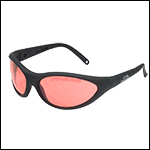
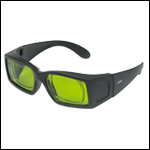
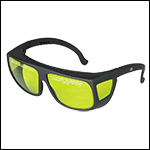
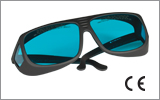

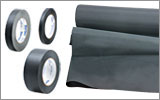

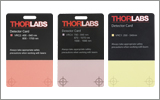

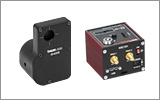

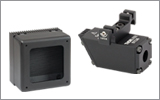

 ズーム
ズーム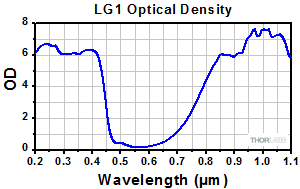



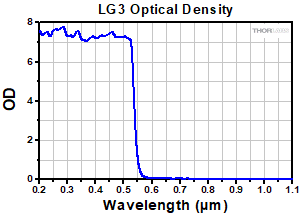

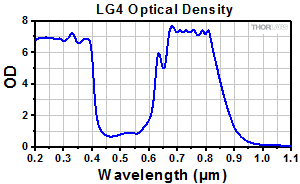
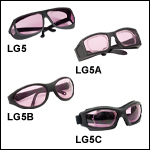
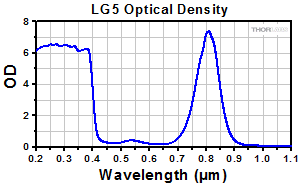
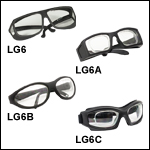
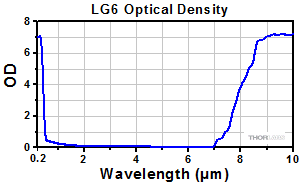
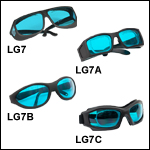



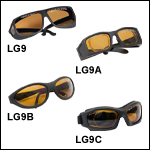
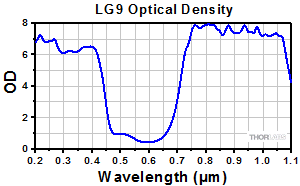


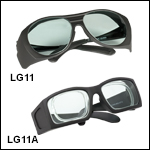
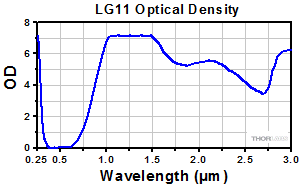




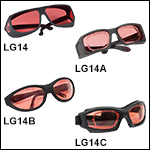



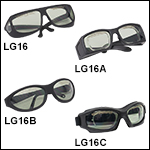

 レーザ保護メガネ
レーザ保護メガネ